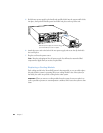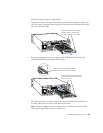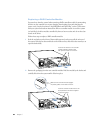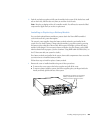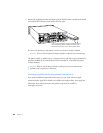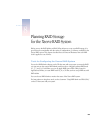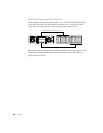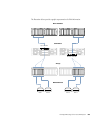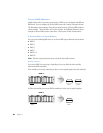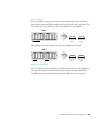60 Chapter 7
RAID Levels
The Xserve RAID system supports several RAID levels. Each level has a different architecture
and provides varying degrees of performance and fault tolerance. Each level has
characteristics to achieve maximum performance or redundancy depending on the data
environment. Understanding the differences among RAID levels will help you set up your
Xserve RAID system to best meet your data performance and security needs.
RAID 0: Data striping without fault tolerance
Also referred to as striping, RAID level 0 is a performance-oriented mapping technique for
disk sets. Uniform subsets of the array’s logical volume, called stripes, are mapped in regular
sequence to a set’s drives, or elements. Using either independent or parallel access, RAID 0
provides high I/O performance at low cost. But RAID 0 offers no redundancy, so it is not
recommended for use with the Xserve RAID system. (RAID 0 can be combined with other
techniques to provide data redundancy, regeneration, and reconstruction, however.)
This level of RAID should never be used in mission-critical environments. It may be
acceptable as a working environment or “scratch disk.”
RAID 0 is easy to configure and has a simple structure; it requires a minimum of two drives.
RAID 1: Mirroring
RAID level 1, mirroring, has been used longer than any other RAID level and remains popular
because of its simplicity and high levels of reliability and availability. Mirroring uses two drives
or multiple drive pairs. Each drive in a pair stores identical data. RAID 1 may use parallel
access for high transfer rates but more commonly uses independent access for high
transaction rates. RAID 1 provides very high data reliability and improved performance for
read-intensive applications, but this level has a high capacity cost because it retains a full
copy of your data on each drive in a pair. RAID 1 has the highest Error Checking/Correction
(ECC) disk overhead of all RAID variants—100 percent.
Common applications of RAID 1 are accounting and payroll, or any application requiring high
data availability. RAID 1 requires a minimum of two drives. In a RAID 1 configuration, the
capacity of the smallest drive is the maximum storage area. Additional drives provide more
redundancy, and thus more protection, but no additional capacity.
RAID 0+1: High data-transfer performance
RAID 0+1 is a combination of level 0 (striping) and level 1 (mirroring). The RAID controller
sets up mirrored pairs of drives and adds striping across the pairs. This RAID level gives the
high performance of striping and the reliability of mirrored data, but it has the disadvantage
of requiring double the drive capacity and is therefore fairly expensive.
RAID 0+1 requires a minimum of four drives.



